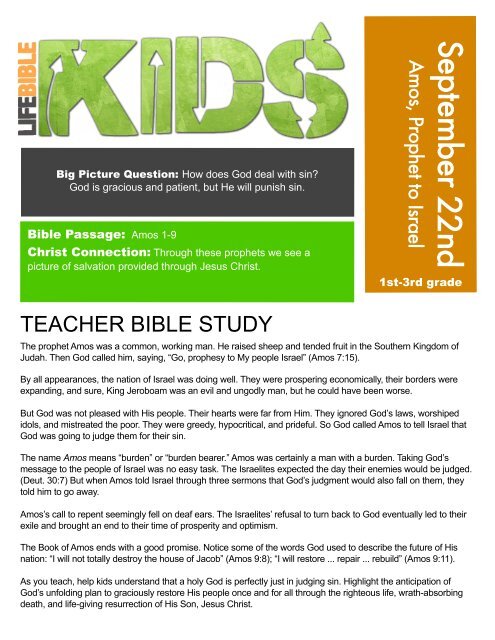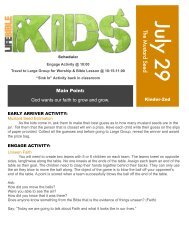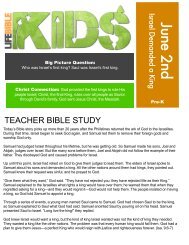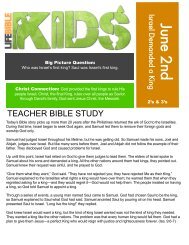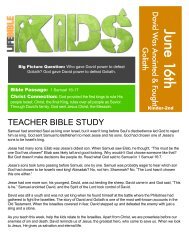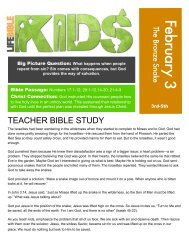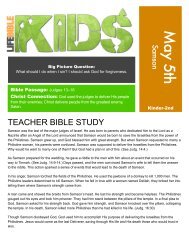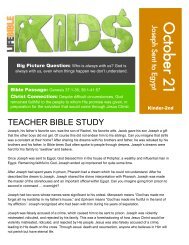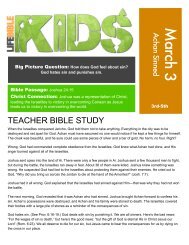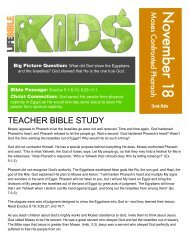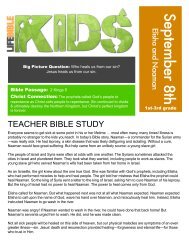1st-3rd Small Group Lesson - Life Bible Kids
1st-3rd Small Group Lesson - Life Bible Kids
1st-3rd Small Group Lesson - Life Bible Kids
You also want an ePaper? Increase the reach of your titles
YUMPU automatically turns print PDFs into web optimized ePapers that Google loves.
Big Picture Question: How does God deal with sin?<br />
God is gracious and patient, but He will punish sin.<br />
<strong>Bible</strong> Passage: Amos 1-9<br />
Christ Connection: Through these prophets we see a<br />
picture of salvation provided through Jesus Christ.<br />
Amos, Prophet to Israel<br />
September 22nd<br />
<strong>1st</strong>-<strong>3rd</strong> grade<br />
TEACHER BIBLE STUDY<br />
The prophet Amos was a common, working man. He raised sheep and tended fruit in the Southern Kingdom of<br />
Judah. Then God called him, saying, “Go, prophesy to My people Israel” (Amos 7:15).<br />
By all appearances, the nation of Israel was doing well. They were prospering economically, their borders were<br />
expanding, and sure, King Jeroboam was an evil and ungodly man, but he could have been worse.<br />
But God was not pleased with His people. Their hearts were far from Him. They ignored God’s laws, worshiped<br />
idols, and mistreated the poor. They were greedy, hypocritical, and prideful. So God called Amos to tell Israel that<br />
God was going to judge them for their sin.<br />
The name Amos means “burden” or “burden bearer.” Amos was certainly a man with a burden. Taking God’s<br />
message to the people of Israel was no easy task. The Israelites expected the day their enemies would be judged.<br />
(Deut. 30:7) But when Amos told Israel through three sermons that God’s judgment would also fall on them, they<br />
told him to go away.<br />
Amos’s call to repent seemingly fell on deaf ears. The Israelites’ refusal to turn back to God eventually led to their<br />
exile and brought an end to their time of prosperity and optimism.<br />
The Book of Amos ends with a good promise. Notice some of the words God used to describe the future of His<br />
nation: “I will not totally destroy the house of Jacob” (Amos 9:8); “I will restore ... repair ... rebuild” (Amos 9:11).<br />
As you teach, help kids understand that a holy God is perfectly just in judging sin. Highlight the anticipation of<br />
God’s unfolding plan to graciously restore His people once and for all through the righteous life, wrath-absorbing<br />
death, and life-giving resurrection of His Son, Jesus Christ.
THE BIBLE STORY<br />
Amos, Prophet to Israel<br />
Amos 1–9<br />
God’s people had been divided into two kingdoms for many years: the Kingdom of Judah in the south, and the<br />
Kingdom of Israel in the north. Amos lived in Judah. He raised sheep and grew fruit. One day, God called Amos. God<br />
said, “Go, prophesy to My people Israel.” Amos had never been a prophet. He was a farmer! Amos obeyed God. He went<br />
to Israel to tell the people God’s message.<br />
Everything seemed to be going well for the people of Israel. They were successful and powerful. They were ruled by King<br />
Jeroboam. Jeroboam was an evil, ungodly king, but the people knew he could have been worse.<br />
God could see what no one else could see. God could see His people’s hearts. The people did not love God. They were<br />
greedy and unfair. They sinned a lot.<br />
God is holy, and He punishes sin. God was planning to punish the people of Israel for their sins. Amos’s job was to<br />
warn the people. Amos told them how God was going to punish them.<br />
First, Amos said that God was going to punish the countries around Israel because they had done terrible things.<br />
But God’s judgment didn’t stop there. When Amos announced that God was going to judge Judah and Israel, too, that<br />
was news God’s people did not want to hear!<br />
It made sense that God was going to punish Israel’s enemies; they did not know and love God. But God’s own people<br />
were not that different from the people around them. They mistreated the poor and worshiped idols. The people of Israel knew<br />
that God had been faithful to them and that He had saved His people from slavery in Egypt, but they rejected Him anyway.<br />
Amos told Israel what God was planning to do: “An enemy will come and take away your power and steal<br />
everything you have.” Amos reminded the people of what they did wrong and of all the times they turned away from God.<br />
“Seek God and live!” Amos said. “Don’t you know where you are? God is in control of everything! God put the stars in<br />
the sky. He tells the sun when to rise and when to set, and He brings the rain. God created all of this, and He can<br />
destroy it too!”<br />
Amos told Israel it was time to wake up! God didn’t want people to just pretend they loved God. He didn’t want them to<br />
make offerings or sing songs to Him if they didn’t mean it. God wanted His people to be righteous. He handed down their<br />
punishment: “I will send you into exile.” God’s people would be forced to leave their country.<br />
God showed Amos visions of what Israel’s punishment would be like. A vision is like a dream, except Amos wasn’t<br />
sleeping. He was awake. First, God showed that He was going to send locusts. The locusts ate up all the crops. Amos<br />
prayed and asked God not to send the locusts. God agreed.<br />
Then God showed Amos a fire. The fire burned up the land. Amos said, “God, please stop!” So God agreed not to<br />
send the fire. Then God showed Amos a plumb line. A plumb line is a tool used to measure how upright, or straight,<br />
something is. God would use the plumb line to measure the righteousness of Israel. “I will punish them for their sins,”<br />
God said.<br />
A priest named Amaziah told King Jeroboam about the things Amos said. Amaziah went to Amos. “Go away!”<br />
Amaziah said. “We don’t want you here! Go back to Judah.” Amos told Amaziah, “God will do what He said, and the people<br />
will be taken far from home.”<br />
God showed Amos another vision. Amos saw a basket of ripe summer fruit. God compared the fruit to Israel. Ripe<br />
fruit would soon be rotten. God would soon throw Israel out. Then in the last vision, Amos saw God standing beside<br />
the altar.<br />
The message to Israel ended with a reminder: God is merciful and loving. God’s plan wouldn’t end with Israel’s<br />
punishment. When the time of punishment was over, God would rebuild the family of King David. God promised to bless<br />
Israel and make the people successful again. Then God promised that His people would never again be taken from their<br />
land.<br />
Christ Connection: God is holy and just, but He is also loving and gracious. God wanted His people to turn back to Him, but<br />
they refused. Israel faced the punishment for their sin. God sent Jesus to take the punishment for our sin. God accepts<br />
anyone who trusts in Jesus as Lord and Savior.<br />
Our Prayer for You:<br />
That this week we will experience the fullness of GOD’s love and grace in our lives. We<br />
have been redeemed by the blood of the Lamb, and we can live holy and set a part from<br />
the world.
WELCOME TIME<br />
As the kids arrive, ask them questions that might help you get to know them better. This is the time<br />
that makes or breaks how welcome a child feels and whether they will come back or not! Be<br />
friendly! :)<br />
EARLY ARRIVER ACTIVITY [9:45-10:00] (begin as soon as children enter; this activity is not<br />
neccessary for ALL children, it just gives the early arrivers something to get started on)<br />
Left and Right<br />
Tape a line down the middle of the room. Remove any obstacles between the line and the walls on each side<br />
of the line. Make sure the kids understand the difference between their left and right. Invite them to stand on<br />
the line and face the leader. The leader will then call out “left” or “right.” The kids must race toward the wall in<br />
the direction that was called out. Any kid who starts the wrong way must sit out a few seconds. To make the<br />
game more interesting, the leader should try to trick the kids. For instance, say “left” while pointing to the right.<br />
Say: “You had to listen and then obey to do the right thing. The Israelites struggled to do that too, so God<br />
sent someone to warn them once again. We’ll talk about that in today’s <strong>Bible</strong> story.”<br />
ENGAGE ACTIVITY [10:00-10:10] (begin @ 10:00; even if children haven’t finished the Early Arriver Activity;<br />
this sets up the <strong>Bible</strong> Story for the day)<br />
Kind Word Toss<br />
Invite the kids to form a large circle or form smaller groups. Each group will need a paper wad, ball, or<br />
beanbag. Say something that would be kind or encouraging to do or say, and toss the ball to a kid in the<br />
circle. Invite him to say something he could do that would be kind or encouraging, and toss the ball to<br />
someone else. After a few minutes, vary the game. Invite the kid holding the ball to say something she likes<br />
about one of the kids in the circle, and toss him the ball. Continue playing as time allows.<br />
Say: “God wants us to be kind to others, but the Israelites had a hard time understanding this. God warned<br />
them, but did they listen? We’ll find out in just a few minutes.”<br />
TRANSITION TO LARGE GROUP [10:10]<br />
Note: Please be sure to stay with your class to help children stay focused and listen to the<br />
lesson. Be sure to actively participate with your class. They are looking to you as the<br />
example to follow!<br />
LARGE GROUP BIBLE STORY & WORSHIP [10:10-10:40]<br />
Big Picture Question: How does God deal with sin?<br />
God is gracious and patient, but He will punish sin.
Note: As students come back to the classroom, it is a good time to distribute snack as you<br />
take prayer requests and praises.<br />
PRAYER TIME [10:45-10:55]<br />
Use the class Prayer Journal to write down any prayer requests that the kids might have, as well as any<br />
prayer requests that have been answered! Take time for the kids to praise God in prayer and lift up the<br />
prayer requests mentioned. Allow 1 or 2 students to pray and then pray to close out the time of prayer.<br />
Remember, kids are learning to pray by your example. The importance and energy you put<br />
into prayer will be directly reflected in your class!<br />
BIBLE STORY REVIEW [10:55-11:05]<br />
Encourage the kids to find the Book of Amos in their <strong>Bible</strong>s. Help them as needed.<br />
Say: “Amos, like all the Minor Prophet books, is located near the end of the Old Testament. These books can<br />
be hard to find because they are usually only a few pages long. There are 12 minor prophets. Can any of you<br />
name some of them?” (Hosea, Joel, Amos, Obadiah, Jonah, Micah, Nahum, Habakkuk, Zephaniah, Haggai,<br />
Zechariah, Malachi)<br />
Use the Timeline to show kids today’s <strong>Bible</strong> story. Review the <strong>Bible</strong> story provided using the bold text, or<br />
summarize the story in your own words. Show the kids a real plumb line or make one by tying a string at the<br />
top of the pencil. Ask one of the true or false questions below. Encourage kids who think the answer is true to<br />
quickly run and touch any wall. If they think it is false, they must quickly trade seats. Hold the end of the string<br />
and drop the pencil. Tell the kids they have until the pencil stops moving to either change seats or go touch a<br />
wall. Reveal who is correct.<br />
• Amos lived in Israel. (False, he lived in Judah.)<br />
• Amos was a farmer. (true)<br />
• God used Amos to warn Israel. (true)<br />
• The people agreed to turn back to God. (False, they asked Amos to leave.)<br />
• God gave Amos a vision about fruit. (true)<br />
• Amos told the people God was OK with their sin. (False, he told them their sin would be punished.)<br />
• Amos promised that even though they would be punished for their sin, God would one day bless<br />
them again. (true)<br />
Say: “Amos warned the people to seek God, but the people continued to worship other gods and mistreat<br />
each other. They continued to sin. How does God deal with sin? God is gracious and patient, but He will<br />
punish sin.”<br />
“Through visions, God shared with Amos the punishment for their sin. An enemy would destroy their homes<br />
and force them to move away. Many years later, God kept His promise to punish His people for their sin, but<br />
He remained gracious and patient. He sent other prophets to warn the people too. God also left them with a<br />
promise to one day bless His people again through the family of David. We see that blessing through Jesus,<br />
who was part of David’s family.”<br />
Show the Big Picture Question poster.<br />
Say: “Does anyone remember the answer to the Big Picture Question? How does God deal with sin? God<br />
is gracious and patient, but He will punish sin.”<br />
Key Passage: “I knew that you are a gracious God and merciful, slow to<br />
anger and abounding in steadfast love, and relenting from disaster.”<br />
Jonah 4:2
KEY PASSAGE ACTIVITY [11:05-11:10]<br />
Make sure the Key Passage, Jonah 4:2, is visible for each child. Read the verse together.<br />
Say: “Did God want to punish Israel? No, the verse we just read reminds us that God is loving and patient.<br />
But the people refused to listen to warnings from prophets like Amos. How does God deal with sin? God is<br />
gracious and patient, but He will punish sin. Let’s work on our “warning” voices as we learn the Key<br />
Passage.”<br />
Encourage the kids to say the Key Passage together. Invite them to pretend that they are trying to get<br />
someone’s attention to warn them. Demonstrate how they should start the verse in a soft whisper and slowly<br />
get louder to make sure everyone can hear. Repeat a few times. Then, go from loud to soft.<br />
SINK IN ACTIVITY [11:10-11:20]<br />
Stars<br />
Provide six wooden craft sticks for each kid. Demonstrate how to use three of the sticks to make a triangle.<br />
Overlap the ends and glue them together. Make a second triangle. Explain how to stack and glue the two<br />
completed triangles to form a six-pointed star. Allow the kids to color or paint the stars and tie a piece of yarn<br />
or string through one of the points of the star to hang it.<br />
Say: “You can hang this as a reminder that the same God who created the stars created you to know and<br />
love Him.”<br />
EXTRA ACTIVITY (can be sent home as a fun activity for families to work together if you do not get around to<br />
doing it) There is a Coloring Sheet if you need it, depending on the length of the service.<br />
***THE HANDOFF***<br />
As children are picked up, briefly state one of the things that were talked about in<br />
class today. You can do this by asking the child a question in front of their parent, or<br />
remind them of something they learned. Also, direct parents and kids to the website<br />
for the Family Journal page- a way for parents to lead their kids to know<br />
Christ at home!<br />
Supplies Needed: masking tape, bean bag, plumb line (string at top of pencil), craft sticks, glue,<br />
string


